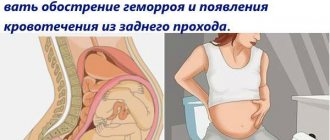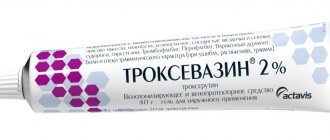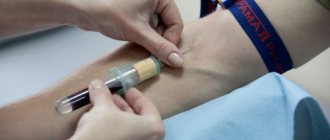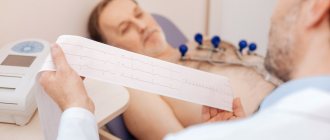Bags under the eyes are not just a cosmetic defect , but in some cases they are a sign of internal pathological processes . This does not mean that you should not spend time eliminating external symptoms, although first of all you should undergo an examination by specialists to find out the cause of such a disorder.
And as a remedy that will help get rid of the external manifestations of these disorders , you can use Troxevasin cream.
What is Troxevasin
A medicine based on the angioprotective active substance troxerutin. Regulates the tone of capillary vessels and veins. It is used to eliminate pain, swelling and trophic disorders caused by their dysfunction.
Troxevasin is produced:
- in the form of an ointment for topical use: a viscous yellowish gel-like mass containing 2% troxerutin, packaged in 40 g tubes;
- in the form of capsules for oral administration: in a dosage of 300 mg of the active substance, gelatin, in blisters.
The product has a pronounced venoprotective effect. It helps reduce the permeability of vascular walls, improves blood outflow, prevents its stagnation in the lower extremities, prevents thrombus formation and the development of inflammatory processes. Troxevasin alleviates the underlying symptoms of varicose veins and slows down its progress.
Mechanism of action of drugs
For patients with venous diseases, doctors prescribe tonic medications for external and internal use. Most of these drugs contain the active component troxerutin. This is a derivative of rutin, which has a positive effect on the condition of the vein walls.
The modern pharmaceutical market offers a huge selection of such drugs and similar analogues. The most popular are “Troxevasin” and “Troxerutin” (Russian analogue). While highly effective, they have a minimal list of adverse reactions.
Most patients were satisfied with the results of treatment with these drugs. But before we find out which is better and what is the difference between Troxerutin and Troxevasin, let's take a closer look at the mechanism of action of both drugs.
Therapeutic effects of drugs:
- – anti-inflammatory;
- – antithrombotic;
- – venotonic;
- – hemostatic (stops microscopic bleeding in the capillaries);
- – capillarotonic;
- – anti-exudative (relieves swelling caused by plasma leakage).
"Troxevasin" and "Troxerutin" are prescribed to patients with the following diseases:
- – thrombophlebitis (veins become inflamed and blood clots form in them over time);
- – chronic insufficiency of the venous system (severe heaviness in the lower extremities);
- – periphlebitis (tissues near the venous vessels become inflamed);
- – sprains and bruises;
- - haemorrhoids;
- – varicose dermatitis;
- – capillary network.
Restrictions on the use of external preparations:
- – first trimester of pregnancy;
- – children’s age (up to 15 years);
- – personal intolerance to components.
Restrictions on taking medications for internal use:
- – renal and liver failure;
- – disruption of the gastrointestinal tract;
- – pregnancy (1st trimester);
- – individual intolerance to one of the components of the drug.
Preparations in the form of gels and ointments are prohibited from being applied to damaged skin (cuts, abrasions, irritations, rashes). Otherwise, an allergic reaction or burning sensation may occur in the bottom area.
Itomed or Ganaton, which is better?
What is Troxevasin used for?
Medicinal ointment and capsules are prescribed:
- for chronic venous insufficiency;
- lack of nutrition of soft tissues caused by varicose veins;
- with postphlebitic syndrome;
- trophic ulcers;
- for symptoms of hemorrhoids;
- with retinopathy against the background of hypertension and diabetes.
The drug is used to prevent complications after surgical treatment of varicose veins, to prevent further vascular damage in the initial stages of pathology. Troxevasin is also indicated to improve well-being after mechanical injuries: bruises or sprains.
The active substance from the capsules is absorbed in the intestines. Its maximum concentration in the blood is observed 1.5–2 hours after administration. Metabolized by the liver and completely leaves the body within 0.5–1 day. Troxerutin from the ointment penetrates all layers of the epidermis, dermis and subcutaneous tissue within 3–5 hours.
"Troxevasin"
There are gels and ointments for external use, and capsules for internal use. The main active ingredient of the drug, regardless of the release form, is troxerutin.
- One gram of gel contains 2 milligrams of troxerutin (concentration 2%).
- One capsule contains 300 milligrams of active substance.
- An aluminum tube contains 40 grams of ointment or gel.
- Capsules are sold in plastic containers. It may contain 50 or 100 capsules.
When is Troxevasin contraindicated?
It is prohibited to take the drug orally:
- with exacerbations of ulcerative lesions of the gastrointestinal mucosa;
- some forms of gastritis;
- severe renal failure;
- increased sensitivity to the active or excipients of the drug.
The use of ointment should be avoided:
- if an allergic reaction to the drug develops: increased swelling, rash, severe burning or itching;
- with severe irritation, furunculosis, open skin lesions at the site of application of the product.
"Troxerutin"
The drug has a similar active substance. Release form: gel for external use and capsules for internal use. One aluminum tube can contain 10, 20 or 40 grams (2% concentration).
- One capsule contains 300 milligrams of troxerutin.
- Sold in 50 and 100 capsules in a plastic container.
The drug is prohibited from taking:
- – children under 15 years of age;
- – nursing women;
- – first trimester of pregnancy.
How to use Troxevasin capsules
The medicine should be swallowed with water, without chewing or crushing. Meal times don't matter. At the beginning of therapy, take 1 capsule. three times a day. Diabetic retinopathy and other severe conditions require up to 1800 mg (6 capsules) per day.
The course is continued for up to 15 days. After assessing the effectiveness of the dose, the dose is adjusted. It may increase or decrease. If the symptoms of the pathology subside, at the discretion of the doctor, therapy can be completed without a maintenance period. Otherwise, Troxevasin is taken for another 3-4 weeks.
Possible side effects
Possible adverse reactions of the body to Troxevasin and Troxerutin:
- - dizziness;
- - weakness;
- - headache;
- – allergic manifestations (itching, redness, urticaria);
- – flatulence;
- - attacks of nausea.
Adverse reactions depend on the method of use of the drug. The use of the gel most often provokes local allergies. Taking capsules may be accompanied by headache or depression.
How to use Troxevasin ointment
The drug is used externally: on clean skin over the lesion. A small amount of ointment is distributed over the body area in a thin layer, lightly rubbing it in until completely absorbed. After application, you can leave the skin open or apply fixing bandages, bandages, and put on compression stockings and bandages if necessary.
The procedure for applying the medicine is repeated twice a day: in the morning and in the evening. If this is not enough, do it more often. There is no need to specifically rinse off any remaining drug before applying again. The duration of treatment with ointment is up to 7 days. If there is no result or the physical condition worsens, the medicine is discontinued and another method of therapy is chosen.
Is it permissible to take these drugs at the same time?
You cannot combine medications. During treatment, it is possible to replace one drug with a similar drug. The simultaneous use of these drugs will not enhance the effect. Medicines have the same composition and dose, so when they are combined, the concentration of the active component will be excessively high. This will trigger an overdose. Adverse reactions will occur and the therapeutic effect will be significantly reduced.
A tooth hurts, what to do at home to make the pain go away quickly, tablets for toothache, folk remedies
Patient reviews
“When I was preparing my diploma in my last year at the institute, I often had to stay awake at night, and during the day I was forced to work part-time, so I spent several hours a day sleeping, which was clearly not enough for my body .
Mentally, I could easily withstand such stress, and all the disturbances were reflected more on my face: my skin became painfully pale, and noticeable bags appeared under my eyes .
My mother gave me troxevasin ointment , claiming that this remedy helps relieve swelling.
I knew that this ointment is used for varicose veins, but I believed my mother and used this remedy for three days to eliminate the bags.
Which drug is better?
Which is better, Troxerutin and Troxevasin? When choosing a medicine, you need to take into account the characteristics of the disease, the presence of allergic reactions to the components that are part of the drug.
Doctors consider Troxevasin to be a better medicine. It is not recommended to replace it with similar means. Therapy must be carried out according to the clear instructions of a specialist.
"Troxerutin" has a smaller list of restrictions. It’s just that the manufacturer of a foreign product does not want to be held accountable for something that has not been fully studied. For example, “Troxerutin” can be used by children over 15 years of age. "Troxevasin" can only be used after 18 years of age.
Diabetes
This disease often provokes disorders of the venous system. Using Troxevasin will help relieve swelling and strengthen blood vessels.
- If there is severe heaviness in the lower extremities, it is better to use Troxevasin Neo, an improved version of the popular remedy.
- In complex therapy of diabetes, Troxerutin is often prescribed.
Haemorrhoids
Troxevasin ointment is more suitable for the treatment of this disease. It should be applied to externally located hemorrhoids. For greater effect, it is recommended to soak a cotton swab with ointment and place it on the problem area for 15 minutes. Before using this product, you need to visit a proctologist.
- Most patients note a significant improvement in their condition after the first use of the drug.
- The pain syndrome decreases, hemorrhoids decrease in size.
Cosmetology
The tonic effect of the drugs allows them to be used for cosmetic purposes. Apply in a thin, even layer.
- The product relieves swelling, eliminates circles under the eyes and spider veins.
- A gel is more suitable for applying to the face.
- For dry and thin skin, it is better to use Troxevasin. It has a denser consistency, so it lies on the skin in an even layer.
Causes and symptoms of dark circles under the eyes
For your information! Most often, bruises under the eyes appear due to the influence of external negative factors, which include:
- presence of bad habits (smoking, drinking alcohol in excessive quantities);
- unhealthy diet , in which there are too many dishes and foods with a high salt content;
- lack of fluid in the body (this deficiency can only be replenished by drinking about two liters of water and other drinks per day);
- sleep disorders and lack of sleep;
- constant stress and emotional disorders ;
- atrophic processes in the skin tissues under the eyes (begin in old age and are usually irreversible).
But in some cases, such disorders can be pathological and indicate diseases of internal organs and systems.
Useful video
From this video you will learn how to get rid of bags under the eyes:
Troxevasin can be used against bags under the eyes , but it is necessary to additionally use moisturizing creams and skin softening agents, since while eliminating bags, troxevasin simultaneously has a detrimental effect on the epithelium.
In addition, you should not rely only on cosmetics : you need to get rid of bad habits, spend more time in the fresh air and adjust your diet, then the bags will be much easier to deal with.
Instructions for use
The instructions for use regulate the method of use of each dosage form.
- The gel is used to treat problem areas of the body no more than 2 times a day (in the morning and before bed). The composition is rubbed into the epithelial layer with light massaging movements until completely absorbed by the skin (15-20 minutes). The phlebologist individually determines the dosage and frequency of application of the medicine. A pronounced therapeutic effect is observed with systematic use of the drug.
- Tablets are taken orally, 1 pc. 2 times a day. The limit dose is 600 mg, with the possibility of increasing it to 800 mg as prescribed by a doctor. The duration of therapy varies from 4 to 8 weeks, based on the advanced stage of the disease, symptoms and condition of the patient.
The instructions presented above are relevant for both troxerutin and troxevasin. There are no differences in taking medications.
Indications and contraindications
Indications for the use of troxevasin and troxerutin coincide (according to the official instructions) by 99%. These pharmaceuticals are prescribed to patients with the following vascular pathologies:
- increased venous permeability;
- varicose veins (including hemorrhoids);
- dysfunction of capillary blood flow;
- thrombophlebitis;
- phlebitis;
- venous insufficiency;
- intravascular inflammation;
- chronic or acute form of hemorrhoids;
- varicose veins due to diabetes mellitus.
Some patients use ventonics to treat ear diseases of various etiologies. Relevant studies have not been conducted, so doctors do not recommend using the medication for other purposes.
Despite their high tolerability, gels are contraindicated for use in patients with the following diagnoses:
- gastrointestinal diseases, associated complications;
- galactose or lactose intolerance;
- renal failure;
- liver dysfunction.
Drugs are prescribed with caution to pregnant women. No official clinical trials have been conducted, and therefore the effect of the drug components on the fetus has not been established.
Side effects
Pharmaceutical products do not cause significant side effects if the doses prescribed by the phlebologist and the frequency of use are followed. In case of an overdose, troxevasin or troxerutin can only provoke allergic reactions in the form of itching, mild burning and redness. Minor gastrointestinal discomfort is allowed for capsules.
The listed effects are temporary and do not require treatment or any intervention on the part of the patient. To eliminate them, it is enough to stop taking the medication.
Directions for use and doses
In accordance with the instructions, the gel is used externally, the tablets are used internally. The dosage and duration of the course of treatment are prescribed by the attending physician. In the absence of a prescription, it is recommended to use the drug in the following doses:
Troxerutin gel is applied to the problem area in a thin layer
- Elimination of the consequences of bruises and abrasions - 3-5 cm per problem area 2-3 times a day. Duration of therapy is 4-5 days.
- In cosmetology (including for bruises under the eyes), troxerutin is applied in a thin layer with an even distribution of the composition, 1 time per day, 1 g. The course lasts up to 4 days with the possibility of extension.
- Treatment of inflammation of hemorrhoids, varicose veins - troxevasin is used no more than 2 times a day. Course duration is up to 1 month.
- The tablets are taken orally no more than 2 times a day, 1 piece each, and the daily dose should not exceed 600 mg. In rare cases, it is increased to 800 mg. The duration of course therapy is until clinical symptoms are eliminated. For therapeutic purposes – 1 capsule weekly.
The indicated dosages are average values. They do not take into account the characteristics of the patient, the severity and neglect of the disease. The safest option is to consult a doctor.
What is the difference between troxevasin and troxerutin?
When choosing one of two drugs, it is important to carefully study their composition, features of action and contraindications. It is very simple to determine the difference between troxevasin and troxerutin - just compare the components of the drugs with each other. But, according to this criterion, medications are complete analogues.
What's the difference?
- The drug troxevasin is produced by the Icelandic company Actavis Group and a Bulgarian company called Balkanpharma.
- Troxerutin is produced in 4 countries - Russia, Belarus, Bulgaria and the Czech Republic.
The main difference is the price of the drug. The average cost of troxerutin is 2-3 times lower than that of troxevasin. As for the active components and minor ingredients in the composition of the pharmaceutical products under consideration, they are almost completely the same.
Rules for choosing a dosage form
After carefully studying the dosage forms of the two medications, it becomes clear that both brands are available in capsule and gel form. The only correct conclusion suggests itself - troxerutin is a complete analogue of troxevasin. The dosage form is not the determining criterion when choosing a drug.
Much more important are the recommendations and appointment of a phlebologist:
- The gel is used externally for local treatment of problem areas of the body. With its help, pathogenic processes and accompanying symptoms are stopped.
- The use of capsules is indicated for complex therapy of severe pathology (moderate and severe forms of severity). Often combined with other forms of drugs to achieve the desired therapeutic effect.
Self-medication can be as dangerous to health as using the wrong medicine.
General indications for use of this product
Attention! Troxevasin is indicated for use in the following disorders of the skin and vascular system, regardless of the location of the pathological processes:
- hematomas and injuries with accompanying hemorrhages;
- formation of a capillary network ;
- thrombophlebitis;
- bruises;
- any type of swelling.
The drug eliminates such problems due to its anti-inflammatory effect and the ability to stimulate regeneration processes in tissues.
Additionally, the cream helps normalize blood circulation.
Reviews from doctors about troxevasin
Stay up to date! Experts do not always share women’s enthusiasm for troxevasin and urge not to rely on this remedy as the main one when trying to get rid of bags:
“Troxevasin is primarily a medical, not a cosmetic, drug , and its main purpose is to eliminate problems with blood vessels.
Today this remedy is recommended by professional cosmetologists , who confidently talk about the rapid elimination of bags under the eyes with the help of troxevasin.
But ladies should remember: this is a potent drug that has a number of contraindications and side effects , so it is better to consult with specialists before using it.”
Description of drugs
The medications in question are representatives of the pharmacological group of correctors of microcirculatory processes; these drugs are classified as angioprotectors. Troxevasin gel fully corresponds to troxerutin in terms of concentration of active ingredients. Drugs are prescribed to treat varicose veins, restore the elasticity of the walls of blood vessels, eliminate painful symptoms, itching and swelling.
High therapeutic effectiveness is ensured when using gels in the early stages of the disease.
The components of venotonics have pronounced anti-inflammatory, antioxidant and decongestant properties.
pharmachologic effect
It is not advisable to make a comparison between troxevasin and troxerutin due to the identity of the composition and, as a consequence, pharmacological action.
- The active substance of the drug is absorbed by the epithelial layer and penetrates deep into the dermis. The active components have a cumulative effect, which ensures a prolongation of the therapeutic effect relative to the venous walls.
- Troxeratine has a targeted effect on norepinephrine.
Troxeratine has a targeted effect on the pain mediator called norepinephrine, which eliminates vasoconstriction. - The active components suppress leukocyte adhesion to the venous walls, thereby stopping inflammation and eliminating swelling.
- The active element neutralizes the destruction of the endothelium of the venous walls, preventing an increase in the concentration of reactive oxygen species.
The listed features increase lymphatic outflow, capillary resistance, resistance of vascular walls to inflammation, and venous tone.
Composition and release form
Troxevasin and troxerutin are available in two forms - gel and capsules. The encapsulated medication is packaged in plastic blisters (300 mg) of 30 and 50 pcs. packaged. Use only orally for moderate and severe forms of the disease as prescribed by a doctor. Gel (2%) is supplied in 40 g aluminum tubes for external use. This form is suitable for the treatment of vascular diseases at an early stage.
Composition of the medicine:
- troxerutin is the key and only active element in the composition of the drug (concentration in the gel is 20 mg/1 g of product, in the tablet – up to 300 mg/1 g);
- distilled water – 960-980 mg;
- benzalkonium chloride – 1 mg;
- carbomer – 6 mg;
- trolamine – 7 mg.
Auxiliary compounds are included in the medication to increase the effectiveness of the main component, the concentration is nominal.
Knitwear and varicose veins: what you need to know?
When the veins cannot stand it, worried citizens rush to the pharmacy to buy tights, stockings and knee socks. Compression hosiery is indeed one of the main assistants in the fight against varicose veins, but often this is the only information that the buyer has. We have collected a dozen popular questions of interest to potential owners of medical knitwear, and as an expert we invited Mikhail Lukyanenko, vascular surgeon, phlebologist, ultrasound diagnostic doctor, head of the Cardiovascular Center (Novosibirsk).
How do compression products help treat varicose veins?
The mechanism of action of therapeutic compression hosiery is to compress the limb from the outside. While wearing such underwear, constant pressure is applied to the superficial and partially deep veins. This helps normalize venous blood flow and prevents blood stagnation, which is what causes edema to form. In addition, compression products help stabilize the lymphatic system, which can also reduce swelling. Thanks to therapeutic knitwear, the flow of oxygen and nutrients to the tissues of the lower extremities is normalized. The feeling of fatigue and heaviness in the legs becomes less pronounced.
What is a “compression class” and how do products of different classes differ from each other?
The compression class is the degree of compression: the higher the class, the stronger the compression that the knitwear provides. Naturally, the question of the degree of pressure you need should be discussed with your doctor. Pressure is indicated by manufacturers in millimeters of mercury (mmHg). Knitwear of the 1st class (18–22 mm Hg) will help if small vessels are dilated, if after prolonged static load you feel pain and swelling in the legs. In case of multiple dilation of veins, the appearance of “nodes”, as well as during the rehabilitation period after operations on the veins, it is recommended to wear class 2 jersey (23–32 mm Hg). When it comes to chronic venous insufficiency, trophic disorders, and congenital defects of the vascular system, class 3 compression is required (33–46 mm Hg). The most powerful 4th class of knitwear is needed for post-thrombotic syndrome and complicated lymphostasis.
In what cases is prophylactic anti-varicose jersey recommended and how does it differ from therapeutic one?
The pressure exerted by preventive knitwear is quite low - up to 18 mm Hg. Art. Such underwear is used in the absence of pathological changes in the great vessels. Unlike therapeutic knitwear, preventive knitwear has no contraindications. It is recommended for people who, due to their occupation, spend a lot of time standing (for example, working at a counter) or, conversely, constantly sitting (like the vast majority of office workers). In addition, preventive knitwear is indicated in case of long trips and air flights - to prevent blood stagnation in the lower extremities. Those who have a hereditary predisposition to venous disease, take hormonal medications or are overweight should consider wearing preventive knitwear. Among the contenders for such knitwear are also lovers of high heels.
What is better to choose: tights, stockings, knee socks? What are the differences between these products, in which case which one is required?
The type of product required is determined by the level of damage to the venous or lymphatic system. If, according to ultrasound, pathological veins are located only on the lower leg, then it is enough to use knee socks. If changes are also present in the veins of the thighs, then it is necessary to use stockings or tights. In general, without ultrasound diagnostics and an appointment with a phlebologist, you can miss the choice of product and only harm yourself in the future.
How to choose knitwear by size? What parameters need to be taken into account and at what time of day should measurements be taken?
To select knitwear, the circumference of the lower leg and thigh is measured, the length of the limb and the size of the foot are determined. The selection is carried out according to special tables (each manufacturer has their own). In the tables of knitwear, several Latin letters are indicated, each of which indicates a special type of measurement. So, f corresponds to a measurement at 25–30 cm above the knee (thigh circumference). To find out your d value, you need to measure the widest point of the knee joint, for the c value - the widest point of the calf. By measuring the ankle slightly above the bone, you will determine parameter b (the circumference of the shin). In principle, measurements can be taken at any time of the day, but if in the evening you experience a significant increase in swelling, you need to measure in the morning.
Will wearing knitwear interfere with physical activity: playing sports, long walks and other physical activities?
Wearing knitwear not only does not interfere with sports activities, but, on the contrary, improves exercise tolerance and increases training performance. Knitwear is especially recommended for team sports, running, jumping, etc. Compression underwear helps increase muscle tone, muscles warm up better, and blood flow is activated. During activities, for example, athletics, wearing medical jersey helps minimize the feeling of fatigue and heaviness in the legs. The training takes place in a productive mode, the runner feels light even after covering a significant distance.
How to wear compression stockings correctly?
If you do not have significant swelling, which increases significantly when you simply get out of bed, there is no need to put on underwear immediately after waking up. You can calmly take a shower, have breakfast, get ready for work and put on knitwear just before leaving the house. If there is obvious swelling, you will have to put on medical underwear without practically getting out from under the blanket. To put on compression stockings or tights, remove rings or rings as they may damage the product. Use gloves - for example, medical rubber ones. When dressing, your legs should be raised or kept horizontal. Once you put it on, you can begin your usual morning routine.
How to care for compression hosiery and how long do they usually last?
Of course, each manufacturer has its own recommendations for caring for knitwear, but in general they come down to a few universal tips. You need to wash your clothes every day after wearing them, in warm water; hot water is contraindicated, and only by hand. At the same time, the use of household chemicals is contraindicated, but ordinary baby soap is suitable. You cannot dry compression products at high temperatures: on radiators and other heating devices; direct sunlight is also the enemy of compression. Dry special stockings and tights with a towel. In order for the compression garment to dry completely, you must leave it on a horizontal surface away from heating devices, stoves, etc. (the ideal temperature for compression is room temperature). The service life of therapeutic knitwear, of course, depends on its original quality, but proper care is also important. The time range for using underwear is very wide: knitwear can last 6–8 months even with constant wear, but it can tear or stretch just a few days after purchase. Suspiciously cheap knitwear will most likely not last long. High-quality knitwear is quite expensive.
Is it necessary to wear anti-varicose jersey during pregnancy and the postpartum period?
Wearing knitwear is mandatory both during pregnancy and in the postpartum period. As a rule, compression class 1 is sufficient; it is also possible to wear prophylactic knitwear if we are talking about a high-quality product. During childbirth, compression garments are also necessary, regardless of the type of obstetric care - even if a caesarean section is planned. The process of childbirth in any case is a colossal burden for the female body, and compression hosiery, in turn, helps to significantly reduce the risk of problems such as varicose veins, rupture of vein walls, and the formation of blood clots. Stockings are the most comfortable because they can be used at all stages - before, during and after childbirth. There are also tights, but they are used only in the second half of pregnancy.
How to understand that the purchase is not suitable?
There is no universal criterion by which you can determine whether compression hosiery is right for you or not. It is important to focus on your well-being: if you are plagued by severe pain or numbness in your limbs, there is clearly something wrong here - either the knitwear itself is of poor quality, or it was chosen incorrectly. I would like to draw attention to a very important point: there are a number of ailments for which wearing knitwear is contraindicated in principle. These include, for example, diabetic damage to blood vessels, heart failure, atherosclerosis, and skin diseases. Taking into account all the subtleties of choosing underwear and the presence of contraindications, you come to a logical conclusion: you need to choose and wear knitwear only after consulting a specialist - a surgeon, a vascular surgeon (phlebologist), in rare cases, a traumatologist and other surgical specialists. The mode of wearing knitwear and the duration of “compression therapy” are also determined by the specialist.
Source katrenstyle.ru
Photo istockphoto.com
Related products: (compression stockings), (compression tights)








